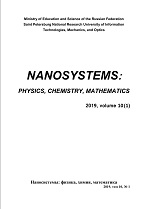|
This article is cited in 5 scientific papers (total in 5 papers)
CHEMISTRY AND MATERIAL SCIENCE
Synthesis, characterization and concentration dependant antibacterial potentials of nickel oxide nanoparticles against Staphylococcus aureus and Escherichia coli
V. Guptaa, V. Kantb, A. Guptaa, M. Sharmaa
a University of Jammu, J&K, India
b Division of Pharmacology & Toxicology, IVRI, Bareilly, UP, India
(Present address: Department of Veterinary Pharmacology & Toxicology, LUVAS, Hisar)
Abstract:
Bacterial resistance to antibiotic treatment is a major emerging clinical and public health issue across the globe. Advancements in the field of metal oxide nanomaterials in the last few years have improved the potential of metal oxides in different applications. Metal oxides, of which, nickel oxide (NiO) is one, also possess antibacterial activities. This investigation was planned to synthesize NiO nanoparticles to study their antibacterial potential in comparison with bulk NiO and standard antibiotics at different concentrations. Synthesis and characterization of NiO nanoparticles was done by standard procedures. The antibacterial potentials of different compounds were determined at different concentrations against S. aureus and E. coli. The diameter of zone of inhibition showed that the antibacterial effect of NiO nanoparticles against S. aureus was better than E. coli at the same concentration. The concentration-dependent effect of NiO nanoparticles was observed from 0.125 to 128 $\mu$g/ml. The effect of NiO nanoparticles was markedly better than bulk NiO at all concentrations. Tetracycline and gentamicin did not show effect below 1.0 $\mu$g/ml and 2.0 g/ml, respectively. The activity index and fold increase of NiO nanoparticles were both higher than 1 and positive, with respect to tetracycline, gentamicin and bulk NiO against S. aureus and E. coli at all the tested concentrations. In conclusion, the NiO nanoparticles seemed to be a more potent antibacterial agent than their bulk form, tetracycline and gentamicin, and in future, their applications may be extended in biomedical field and other areas to reduce microbial infections and incidences of antibacterial resistance.
Keywords:
nickel oxide nanoparticles, S. aureus, E. coli, Antibacterial activity, activity index, fold increase.
Received: 20.03.2020
Revised: 03.04.2020
Citation:
V. Gupta, V. Kant, A. Gupta, M. Sharma, “Synthesis, characterization and concentration dependant antibacterial potentials of nickel oxide nanoparticles against Staphylococcus aureus and Escherichia coli”, Nanosystems: Physics, Chemistry, Mathematics, 11:2 (2020), 237–245
Linking options:
https://www.mathnet.ru/eng/nano520 https://www.mathnet.ru/eng/nano/v11/i2/p237
|

|




 Contact us:
Contact us: Terms of Use
Terms of Use
 Registration to the website
Registration to the website Logotypes
Logotypes








 Citation in format
Citation in format 
